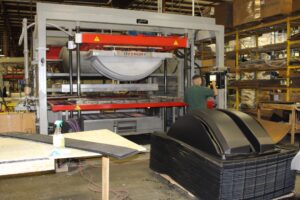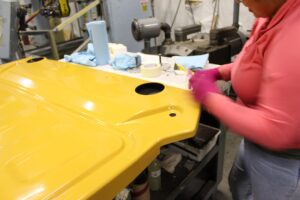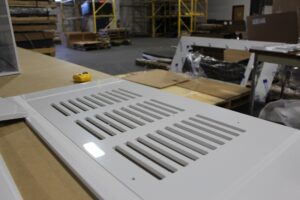Thermoforming Services for Maryland
Serving Maryland from Our Central North Carolina Location

Heavy gauge thermoforming has different methods of meeting the equipment and tool making needs of almost every project. The strides made in engineering technology have made room for the thermoforming process to grow into a system with many branches that each have their own strengths and advantages. There are many sides to the thermoforming process, each carrying a number of details to consider. Aspects such as temperature, surface finish, design, color, and impact resistance must all be thoroughly planned out when thermoforming.
Vacuum Forming

Vacuum forming is the process of siphoning air from between the mold and heated plastic sheet. This is one of the simpler forms of thermoforming, though its straightforward process makes it ideal when molding transparent material such as acrylic.
Vacuum forming excels when it comes to creating larger products that do not rely on defined and detailed edges: dashboards, car bumpers, and construction equipment.
Twin Sheet Thermoforming
Twin sheet thermoforming is the process of taking different halves of a product and molding them separately before merging them together. When it comes to thermoforming, this is one of the most complex methods. The complexity of this method lends itself to the intricate and advanced structures and products it is able to make.
With twin sheet thermoforming, hollow structures with durable exteriors and vacant interiors can be formed. This increases the range of possibilities in reference to what can be produced through plastic forming. Products that are produced from twin sheet forming are air ducts, foam-filled products, and vending machines.
Pressure Forming Plastics
Unlike vacuum forming, which extracts the air from the mold and plastic, pressure forming uses air pressure to push the heated plastic against the mold. This process also uses about three times the air pressure as vacuum forming in order to have the plastic wrap around the mold tighter. Pressure thermoforming causes the edges of the product to be much more defined and detail. In all, this process is known for delivering smooth textures, custom colors, and great precision.

Injection Molding
The injection molding process consists of thermoplastic pellets being heated until it reaches a liquid state. This liquid is then injected into the mold using high pressure. After a cooling period, the parts are ejected from the mold and can then be painted or silkscreened. An advantage of injection molding is low per unit part costs. When used for projects that require a large number of units this feature of injection forming can offset the high tooling costs.
Thermoforming Company Serving the Maryland Area

Searching for a thermoforming company servicing Baltimore, Washington D.C., Frederick, Annapolis, Columbia, Germantown, Silver Spring, Waldorf, Frederick, Rockville, Bethesda, Gaithersburg, and all other areas of Maryland? Contact the leaders in custom thermoformed plastic, Advanced Plastiform, Inc. With its central proximity to the Southeastern US, Mid-Atlantic and Northeast, our North Carolina facilities are uniquely positioned to best serve your Maryland company needs. API offers customers the expertise of staffed engineers and on-site manufacturing and inventory management. From concept to delivery, API is your answer for heavy gauge custom plastic manufacturing.


